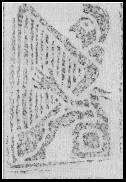

| Newsletter 40 | July 2002 |
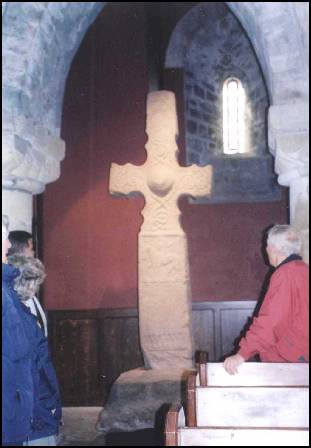
Coming of
the Cross
Our Jubilee challenge
Year of "even more talent"
Snaps from ten years ago
A Dunning farewell
plus more
The Dupplin Cross soon after arriving
in its new home.
Photo by Patricia Wallace
LETTERS FROM NEAR AND FAR
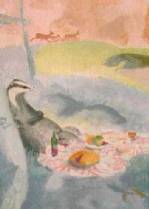
Mary Thomson's cover for |
Sheila Long, Auchterarder: (Writing about the January newsletter) Congratulations on a superb issue.
Don Hepburn, Toronto, Ontario: I have been reading the latest DPHS publication. It becomes better with each issue. Many people must put in a lot of effort to produce it but I think the editor must be the guiding light that gives it the professional touch.
I've mixed feelings on the Dupplin Cross question. It had an excellent place of exposure to many international visitors in the Chambers Street Museum. I saw it there a couple of years ago. The old church in Dunning cannot offer such scope but I suppose I should leave that decision for the people in Scotland who look after it.
Mary McLuckie, Balloch: Visiting St. Serf's this spring, I liked the way the cross stood out. It was illuminated in a lovely warm light, and the old arch framed it beautifully. I think the cross is better displayed in St. Serf's than it was in the Edinburgh museum.
Ken Murdoch, Methven: Your Dunning Parish Historical Society publication is astonishing and I am delighted by your inclusion of the book on "Gask Near Perth". You have been very kind to support the book in the way you have.
Please convey my appreciation to the Committee and the Society members - and full marks for all you are doing for the community.
Eileen Curwell, Australia (through webmaster Simon Warren)
I'm researching my roots and have come up with a puzzle for you. My grandmother was Catherine Penny Cunningham (Mrs. David Cunningham) nee Flockhart who died in 1922 aged 40 and who is buried in Dunning. I believe she was living in Church Wynd with her mother Margaret Penny when she got married in 1910. Catherine's adoptive father was Peter F. Flockhart, handloom weaver who was deceased by 1910.
This is almost certainly the Peter Flockhart in 'Crossroads and Characters' who "was born in 1819 and died in 1908 having lived all his life in Dunning".
Puzzle: Why did Peter adopt Catherine, and who was her real father?
 This newsletter is published quarterly, January, April, July and October by the Dunning Parish Historical Society.
This newsletter is published quarterly, January, April, July and October by the Dunning Parish Historical Society.Editor: Lorne Wallace Contact us At The Old Schoolhouse, Newton of Pitcairns, Dunning, PH2 0SL (Telephone answer machine) 01764 684 448 or personal e-mail lornepat@hotmail.com |
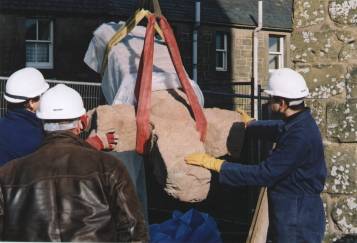 |
Easing |
"Scottish symbol re-sited in Strathearn"
by Felicity Martin
|
(Reprinted courtesy of the Nine years after the dispute over its future began, the Dupplin Cross, which is believed to have been erected in the ninth century to mark the unification of Scotland, has been re-homed in St. Serf's Church, Dunning. In July 1993 local people heard of plans to remove the Dupplin Cross, which had stood on a hillside on the Dupplin Estate overlooking Forteviot for over 1000 years, to Edinburgh. It appeared to be a done deal - the cross would go to the new National Museum of Scotland building to take up a central place in the entrance hall. At the time the cross was erected Forteviot was the capital of Scotland. But the assumption in the early '90's seemed to be that, after conservation to stop further erosion of its carvings, it would reside permanently in Edinburgh, the present capital of the Scottish nation. Under the leadership of the Rev. Colin Williamson, a group called the Friends of the Dupplin Cross quickly formed to campaign to keep the cross in the locality. If it needed to be under cover, then where better than Forteviot Church, within sight of its original home? The Friends of the Cross related to the nine-foot stone in a way that official bodies found hard to appreciate, as Rev. Williamson explained. "We saw it as less of a historical document and more as an elegant and contemporary icon that only relates to the community in which it stood. It was a statement of faith that would have died if it were relocated to a museum." Considerable work was put into drawing up plans to show how the cross could be accommodated in Forteviot Church and into designing and costing the necessary internal modifications and security arrangements. A sponsor was even found - a rich American with connections in Forteviot who was prepared to underwrite whatever it cost.
"It was like David and Goliath," Rev. Williamson said. "The Museum had great confidence in the outcome. We were just an annoyance, a speck in the eye." Sufficient case was made for the Secretary of State for Scotland, who had responsibility for the country's historical heritage, to call an inquiry into the future of the Dupplin Cross. By this time other local bodies had become interested and were lending their support to the Friends. "The Dunning Parish Historical Society were a huge encouragement," Rev. Williamson said. "They came over the hill like the cavalry." As the inquiry approached it was clear to the Friends of the Dupplin Cross that the Dupplin Estate had strong resistance to Forteviot Church as a home for the cross. In a tactical move, which some outsiders saw as a collapse, the Friends withdrew their bid so that other local options could be considered. At this stage St. Serf's Church in Dunning emerged as the best local alternative. Deconsecrated about 20 years ago, it was in the care of Historic Scotland. During the summer months a rota of village volunteers, co-ordinated by the Community Council, opened it for visitors. Many people came simply to search for their ancestors among the old gravestones, dating back to the 17th century. Historic Scotland were in favour of a local solution, as government policy is for carved stones to remain locally wherever possible. Strong support was also gleaned from the Parish of Ruthwell, which a century ago successfully fought to re-home the 7th century Ruthwell Cross in their church, rather than have it removed to a museum. In the end, a compromise was struck. The Dupplin Cross would be removed for conservation then displayed as a showpiece of the National Museum of Scotland for three years, before being returned to Strathearn and placed in St. Serf's Church. In the past the Dupplin Estate did not welcome people going across the fields to view it. Now the cross will be much more accessible. And it will have protection from further erosion, which has accelerated with modern farming practices and acid rain. "Over the past 100 years the erosion has been considerable, especially to the west face - you can see the difference from Victorian photographs," Rev. Williamson commented. "If a satisfactory solution hadn't been agreed, they could have left it standing there for another 1,000 years and it would have ended up as a little heap of sand." After four years away, the Dupplin Cross returned to Strathearn, being installed in St. Serf''s just in time for Easter weekend. It took considerable manoeuvring to erect the imposing slab of carved sandstone, which stands in a socket in a large plinth, in its new home. Its arrival was not advertised, but several Dunningites assembled to watch the installation and record it on film. The cross and plinth arrived on the back of a lorry, wrapped in blue plastic sheeting and netting, like some builder's materials. A crane lifted them over the churchyard wall and scaffolding erected inside the clock tower was used to hoist the cross into position. |
During the time the Dupplin Cross was away - in June 2000 - the Church of Scotland created a new parish, the Stewartry of Strathearn, which joins Forteviot, Dunning, Aberdalgie and Aberuthven. So the cross is still within the extended parish that encompasses its original home. "Generally there has been great delight at the return of the cross to Strathearn," Rev. Williamson reported. "Forteviot folk appreciate that the best local option that was possible had been arrived at. The campaign files of the Friends of the Dupplin Cross will now be lodged with Perth Museum, for future historians to read." Several months before the cross came back, Historic Scotland approached the Dunning Parish Historical Society to ask whether they would be interested in undertaking a contract to open St. Serf's during the summer on behalf of Historic Scotland. This offer was considered carefully by the voluntary organisation. Although in favour of the church being managed locally, the DPHS eventually declined, deciding that becoming an employer of stewards would change the nature of the society. Instead Historic Scotland has employed two stewards, one full-time and the other part-time, to open St. Serf's seven days a week from Easter to the end of September.
Neil Johnston used to live in Dunning and is presently based near Auchterarder, while Garry Malcolm is from Abernethy. Garry's grandfather came from Dunning and worked on the Duncrub Estate as a farrier for Lord Rollo. As yet there is no indication for visitors that the Dupplin Cross is in St. Serf's or that the church is open for viewing. The old sign giving hours when volunteers were present has gone from the Session House window at the entrance to the churchyard and hasn't yet been replaced by an Historic Scotland sign indicating opening hours. Although St. Serf's is signposted from the A9, there is nothing there or in the village to show that the Dupplin Cross has taken up residence. An Historic Scotland spokeswoman said that signs were in production. One interpretive sign, to be placed in the church near the cross, was at the printing stage. It is designed to put the cross in its setting. In addition "biff-bats", portable handheld boards in English, French and German would explain the imagery on each side of the cross.
Although local relationships with Historic Scotland have been good, with DPHS working closely with them, tensions have arisen since the cross was installed. At the suggestion of one Historic Scotland official, Elspeth Pentland, the programme convenor of DPHS started to organise an event to welcome the Dupplin Cross back to Strathearn. However, another official when approached reacted angrily, saying that it was "our" cross and it didn't belong to DPHS. Recent diplomacy has smoothed ruffled feathers and the planned celebrations are going ahead, but not under the ownership of any one organisation. Instead, the event will be for and by the "Folk of Strathearn" and will include anyone who wants to welcome back the Dupplin Cross. The event is scheduled for September 7 and will take the form of a walk from the original site of the Dupplin Cross to St. Serf's in Dunning. After arriving at St. Serf's, Rev. Colin Williamson will perform a dedication for the cross and speakers from Historic Scotland will talk about the moving of the cross and what was discovered during its conservation. Some surprises are in store. Using modern technology conservators were able to read an eroded Latin inscription on a panel on the cross, which says "Constantine mac Fergusa 789-820". Previously it was believed that the Dupplin Cross was erected during the reign - from 843 to 858AD - of Kenneth MacAlpin, who united the Picts and the Scots to create the nation of Scotland. However, historians are now wondering whether the cross could be about 40 years older than originally thought. It may instead celebrate the achievements of MacAlpin's Pictish predecessor. NOTICE OF SPECIAL Preceding our September 12/02 meeting in Dunning Village Hall, a special meeting will be held at 7:30 pm to consider a motion to change the end of the DPHS financial year from March to December 31. Another motion will propose making the date of our AGM between March 1 and April 30, starting in 2003. |

A year of even more talent!
Chairman's report by Raymond Young
I gather that it is customary for the chairman to give a review of the year - highlights, memorable events, and new developments. So here goes . . .
For me, five things stand out during the last year:
The colourful magazine. Few societies of our size can boast the quality magazine that we have. And this year, the addition of colour has made it even better. And Lorne - our editor - has managed to gather a range of articles, some of which are about the village, others of direct interest to those in the village - like the extracts from Ken Murdoch's book on our northern neighbour, Gask. This society owes Lorne a huge debt for the magazine, on top of all the other debts we owe him.
The Website. For those of you who do not have access to a computer, and have never seen the website, sometime ask Simon to let you see it. This is a virtual Dunning museum, full of fascinating facts and pictures. Simon Warren is responsible for the website (his official title is Webmaster) and we are very grateful to him - and the team of people like Alf Marshall who help him - for what is undoubtedly one of the best local websites around. It gets "hits" from all over the world.
The Burns Supper. I doubt if many Burns Nights were as enjoyable as ours this year. Ian Buick, originally from Dunning but now a member from Berwick-on-Tweed and a major Burns performer, thought that ours was the best he had been to this year. And he was at more than 15. This was a real community effort, with a cast of talent from the village (alright, we'll annex Blackford for its fiddlers) and a stage set which transformed this village hall into "Pussy Nancy's" (or was the inn sign correct in identifying the organisational genius of Elspeth Pentland as the brains behind the show?
The weekend. This was this year's innovation. A suggestion made by Elizabeth Fletcher, and taken up by her and Jean Young saw 45 of us in Newtonmore for the weekend. Up Cairngorm (by the funicular), to Culloden (by bus), a bothy night (with numerous performers - it would be invidious to single out any individual), and a final visit to the Highland Folk museum remembering what it was like to be at school and other places. One of the good things about the weekend was that it allowed some of our members to participate who, because they live some distance from Dunning, cannot get to our monthly evening meetings. The weekend was so much enjoyed that by popular demand, Le Weekend has been added to the programme, and Liz and Jean did so well that they have been asked to organise it again! We will look again at the timing: perhaps it is too close to the excellent day bus run that Peter Duncan has been organising for some time. But thanks to these ladies for their efforts.
The gavel. Being chairman of this society is like trying to manage David's huskies, except that there are more committee members (thank goodness) than huskies. The enthusiasm, energy, contacts and commitment of the committee is really impressive. But keeping them together can be fun (that is, difficult). Thanks to George McLean we now have a beautiful gavel that does help to create order out of chaos. It is entirely made from Dunning elm from the Den, and turned in George's own workshop. Again, many thanks to him.
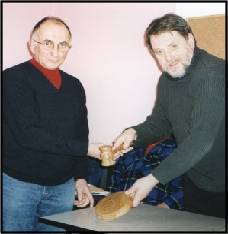 Left, George McLean and the gavel |
These are my personal highlights. The problem with highlights is that one can give the impression that the rest are lowlights. this is certainly not the case. We have enjoyed a wonderful mixture of travel and meetings at home. Talking of travel, there has been an unintentional trains theme this year - we've travelled on trains (at Almondbank), visited train stations (St. Pancras) and seen movies of trains in Strathearn.
In contrast we've seen more of Dunning's wildlife, and thanks to Henry Hoey's drawings, there are examples of our wildlife in rooms across the land in our calendar. David Halliday's huskies added a novel touch to our last AGM (what was it about not appearing with children or animals?)
We're learnt more about our own village and valley - about weavers from Dunning and Strathearn, three towers (Dunblane, Muthill and Dunning) and the fascinating tale of how the Dupplin Cross came to Dunning. And of course, four village 'worthies' gave us an insight into life in Dunning in pre-war days. That was our annual walk! And we got as far as Japan in our members' night.
Do you remember the visit to Stanley Mills? There we met Chris McGregor from Historic Scotland who was responsible for fitting the Cross into St. Serf's and whom we will see again later this year. Which again is a link to my next point. This may be the AGM, but there is plenty more to come. For example, in October we'll be holding a promise auction. What can you offer - baking? Microlight flight?
...See the talent in this village? It is amazing and it is so impressive the way in which it is made available. May I thank on your behalf the large number of people who make this society the quality show that it is. People like Alf Marshall who redesigned our notepaper and Catherine Duncan who makes the posters. In particular, I would like to thank Brian Boag, George McLean and Jim Smith who are retiring from the committee, for all the hard work they have put in over the years. Can I finally thank the other members of the committee for their contribution and their forbearance with me as their chairman, and you the members of the society for supporting the events. I look forward to another year of talent.
- Raymond Young
Elected to the DPHS committee at the 2002 AGM were Chair Raymond Young, Vice-Chair and Treasurer Mike Barwick, Secretary David Halliday, Ted Dorsett, Peter Duncan, Liz Fletcher, Alf Marshall, Elspeth Pentland, Ian Philip, Lorne Wallace, Simon Warren, Jean Young and new members Mike Graham and James Murray.
nnnnnnnnnnnn
Happy birthday to us!
The Dunning Parish Historical Society was started in mid 1992. Which means, though it's hard to believe, that we are now ten years old!
As our 2002-3 committee members plan the next year, they'll have appropriate celebrations and projects in mind. Already underway are:
An enhanced magazine/newsletter for our second decade. See the back cover of this, our fortieth, quarterly newsletter.
A project called "History Now" to feature and preserve for the future modern-day information about the village (see page 18)
A promise auction to raise funds for the above and other new projects. See the insert in this newsletter for auction details.
On the next pages, we hark back to one of the Society's first projects: colour snapshots of villagers, taken in 1992-3, copies of which we sold as a fund-raiser. Flip the page, and perhaps you'll recognise events or people from a decade ago.
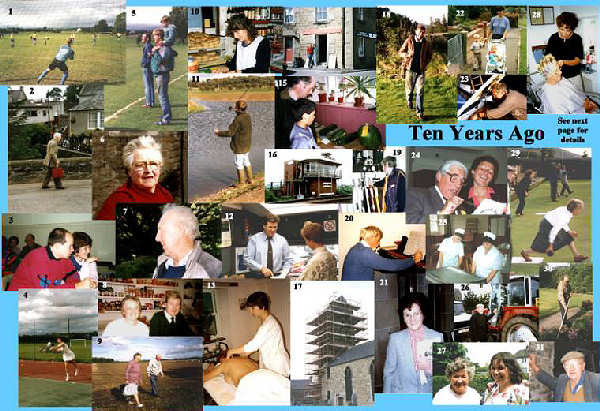
Dunning Images from Ten years Past
- Dunning Heather football team warms up for match with Dunkeld
- Archibald McNicol, 3 Manse Place, crosses Dunning bridge
- Peter and Elaine Macnab (Lorien Cottage, Lower Granco) at "Horse Race" sponsored by Auchterarder Rotary Club in Dunning Village Hall
- Ladies tennis single final. Karen Ogilvy (Castle House, Duncrub) serves.
- Dunning Heather football fans Michael Harper (Granco Cottage, Lower Granco), Peter Proff and son Ian (Cora Linn, Lower Granco).
- Mrs. Isabella Duncan (Hollybank, Townhead)
- Captain Jamie Baker (Wester Keltie)
- Carol and Sandy Kinross in their village grocery shop
- Isabella and Bob Stewart (8 Croft Avenue) walk dog Spot across stubble field
- Shop assistant Jackie Smith (Cornerstones, Kippen Lodge) at Fletcher's shop
- Angler from Perth at Cleary's Dunning Fishery, Leadketty.
- In P&K library van, librarian Ted Allison serves Judi Slater (Kirkgate House)
- Masseuse/aromatherapist Susan Cameron (Strathearn Cottage, Kirkwynd)massages shoulders of a client, actress Clare Richards (The Cottage, L. Granco)
- Matt and Edna Crawford (Kirkstile Square) on the last day of business of their news agency/grocery shop, May 1992.
- David Cowan and son Timothy (No.2 Bungalow, Broadleys Farm) at Dunning Flower Show looking at Timothy's prize exhibit.
- Dunning Signal Box, at site of old Dunning Station, with signalman Tom Wilson(5 St. Serf's Terrace) just visible on platform.
- Early stages of St. Serf's steeple repairs by Historic Scotland
- Henry Hoey (14 Croft Place) on way to a gardening job
- Tom Wilson operates railway signal controls at Dunning Signal Box (see 16)
- Music teacher/arranger/performer Ken Black (Lower Granco) composes at the piano.
- Alexandrina Robertson (Kippen Cottage, Newton of Pitcairns
- Audrey Summerton (7 Bridge of Earn Road) with sons Drew in hand, Jamie in stroller
- Don Ferguson (6 The Granco) at home repairing his car.
- Kenny Laing (Thimble Cottage, Bridgend) and Marion Bruce (25 Kirkwynd) trade tips at a charity "Horse Race" held by Auchterarder Rotary Club in Dunning hall.
- Dunning Primary School new dining room, with cook Mary Clark (Wilmar, Thorntree Square) and assistant Christeen Black (Hideaway, Muckhart Road)
- Janis Gravitas (No. 4 Cottage, Baldinnes) poses by tractor in which he goes shopping..
- Bett Boyd (Nethermuir, Lower Granco) and daughter Lesley Boyd (7 Kirk Wynd) at Dunning Parish Church midsummer fete.
- Dunning Hair Centre. Margaret Graham (Harlaw, Lower Granco) has hair styled by shop owner Stella Clinton (Luncarty)
- Annual match men vs. women at Dunning Bowling Club. Dorothy Wilson (Lynton, Perth Road), playing Dougie Philp (Thorntree Court, Muckhart Road), delivers. In background are Emma McLeish (20 Bridge of Earn Road), Donald Murray (Schoolhouse), Duncan Allan (Alcroft, Newton of Pitcairns)
- Adam Stratton (11 Croft Place) hoes garden at Willowbank House
- Construction worker John 'Jock' Crow (Pansy Cottage, Thimblerow)
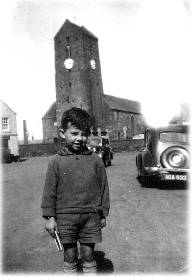 A young subject of George VI: |
Where Were You
When the King Died?
Here are responses
to our Jubilee challenge to members,
asking them to recall the memorable day
when King George VI died.
Alan Kindness: When I left Auchterarder J.S. School in December 1951 I decided to join the merchant navy and see the world. In 1952 I travelled to Norfolk to enrol as a student in the Prince of Wales Sea Training School on a course lasting some 4 months.
Various duties and skills were learned, one of which was to undertake a spell normally of a week's duration as a 'side boy' (naval jargon for 'receptionist'). The duties were in the main: to hoist the Red Ensign at 8 am (sunrise) and lower it again at 6 pm (sunset). In between times the logbook had to be maintained, recording such things as visitors and telephone calls, and the ship's bell had to be rung every half hour. It was the one and only time one worked in full dress uniform.
It was a cardinal sin to look idle and it was therefore necessary to look busy. I used the time to write letters home to my mother, to Dougie Philp's wife Nan (Nan was a land girl at Broadleys when we arrived there in 1943 and I immediately adopted her as my 'big sister') and also to Will Edment's daughter Mary!!
It so happened that I was 'side boy' on the 6th February 1952. I recall being summoned to the commander's office and being ordered to "muster the hands to the flag", no reason being given at that time.
With all hands mustered, the commander then informed us that the king had died, and ordered that the flag be lowered to half mast.
It was then my duty to lower the flag, whilst the chief petty officer sounded the bosun's pipe. I seem to recall that it was a dull, dreich day which added to the sombre occasion.
We all thought that we would be allowed the rest of the day off as a mark of respect - no such luck and it was soon back to our various duties. We didn't even have a day off at the funeral.
I have mused from time to time that the 'side boy' duty served no useful purpose whatsoever when I eventually went seagoing in June 1952. But it did stand me in good stead when I joined General Accident in 1958 after being invalided out of the merchant navy viz always appearing to be busy, writing longwinded letters and watching the clock. The saying "it's an ill wind . . . " etc. etc. somehow springs to mind!
- Alan W. Kindness, Perth
Liz Fletcher: I was nine years old when King George VI died, and I had just undergone the most traumatic experience of my young life.
Food and I were always the best of friends so when I returned from a birthday party complaining of stomach pains, my mother immediately accused me of "making a pig of myself" and despite my denials I was offered no sympathy as I lay writhing in bed.
By the next evening, however, she began to suspect that something really was wrong and telephoned the doctor asking him to call in on his way to the surgery the following morning.
At almost midnight our doctor arrived saying that he couldn't sleep till he saw me as he knew how seldom my mother called him out. He examined me and almost immediately asked for the telephone and I remember him shouting down the phone that it was extremely urgent that an ambulance come immediately. I was much more relieved than scared on hearing this as it proved I really was ill and was not guilty of overeating as charged.
Everything then happened very quickly. I recall the ambulance, bells ringing, painful examinations, being rushed on a trolley into a theatre with an enormous round bluish light shining down on me. My appendix was removed and the surgeon told my worried parents that a delay of only a few hours could have proved fatal.
The next two weeks were spent in the children's ward and I vividly recall the young infant in the cot next to my bed who had overturned a pot of soup on himself. His shoulder, arm and side were all burned and I was fascinated by the 'bits' of vegetables which had stuck to his skin and children being children we curiously examined and identified the lumps as carrots, turnip etc. etc.!
Some of you who come from or live in the Glasgow area may remember the lioness "Sheila" in the stuffed animal section of Glasgow Museum and Art Gallery. She was shot after mauling a boy who had put his arms through the bars of her cage at Calderpark Zoo. I think the boy's name was Henry and he was in the ward at the same time as myself. His arms were so badly damaged by the lioness that they had to be amputated. The ward was the old-fashioned Nightingale style with a large fireplace in the middle, and we children who were mobile had some wonderful races in wheelchairs round the ward 'track'.
Henry, undaunted by his accident, soon learned how to maneuver his wheel chair using only his feet and legs, and won as many races as any of us with two arms, so I am sure with such spirit he would make a success of his life whatever he chose to do.
I came home with a wealth of stories with which to regale my friends but had to return to Yorkhill a few weeks later for a check-up. Having been given the all clear my mother and I were walking down the steep hill from Yorkhill hospital, when I looked across beyond the Art Gallery to Glasgow University. I noticed the flag flying from the building was only halfway up the pole. On asking why this was so, my mother explained that it meant someone important had died, probably one of the university lecturers.
We got home and put the radio on to learn that George VI had died peacefully the night before and we realised then why the flag was at half mast.
Thus I always link the death of King George with my peritonitis, the little boy burned by the soup, and "Henry" and his unfortunate experience with Sheila the Calderpark lioness.
---Elizabeth Fletcher, Dunning
Patricia Wallace: It's strange the things that stick in your mind from your childhood, isn't it? Sometimes it's selective memory. We avoid the unpleasant stuff and concentrate on the positive things, especially as they relate to us. But I have a very clear memory of something so dramatic that I always remembered it.
My mum went back to work when I went to primary school so I went to a friend's house after school. However, this particular day, my child-minder Florence brought me home to my house and there, at the unexpected time of I suppose 4 p.m., was my mother, in tears!
And she wasn't in her "work clothes" but her apron and head scarf. Had she not gone to work that day? Or had she left early? I don't remember. Anyway, there she was, all unfamiliar to me, my predictable mum.
I recall the sinking feeling asking what was wrong. Had anything happened to my pet rabbit or the family cat, or worse, my beloved grandad? But no, it was nothing so personal. She just said "The King has died".
Now I didn't really know this fellow, except through A.A. Milne's rhymes like "They're changing the guard at Buckingham Palace" etc, so it was all a bit remote for me, but she was clearly affected so I kept asking questions. Who was he? did he live near us?
She pulled herself together to answer the demands of her anxious young daughter. She told me how kindly a figure he was, how brave to be a public speaker with such a speech impediment, how he was such a wonderful father to his daughters, that he stayed in London during the war: all the reasons why there was such public sorrow.
Looking back I guess I was sad too, so as a treat we had jelly with bananas and mandarin oranges for tea, which was unheard of during the week: that was a Sunday tea item in our household.
The shock of my mother's tears and the rather puzzling reasons for them have stayed with me ever since , despite our family's ups and downs as well as so many revelations of the royal family's involvement in less appealing aspects of the Second World War.
I don't remember the funeral itself - we didn't have a TV - but I must have seen a newsreel at the cinema of a little figure in black descending the steps of the plane which brought the new queen Elizabeth home. I remember thinking how sad she must be that her dad died, and pondering how my mum didn't know him but was so upset too.
---Patricia Wallace, Dunning
uuuuu
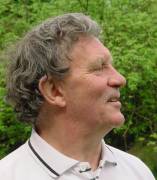 Dr Angus Watson |
Author in Search of Our Help
Angus Watson of Forgandenny is researching a book about Dunning, and asks for help from Dunning parish residents and ex-residents. He's the author of "The Ochils: Place Names, History, Traditions", some of the illustrations for which were pen and ink sketches by the late Kenny Laing of Dunning, who also helped with research for the book.
Since then Angus Watson has completed a PhD at St. Andrew's University with a thesis on place names of western Strathearn. His research included the parish of Dunning.
Dr. Watson's new book will be about the place names of Dunning and will be dedicated to the memory of Kenny Laing.
This summer Dr. Watson will be visiting farmers and other locals in Dunning Parish seeking out information such as ancient field names.
If anyone in Dunning or elsewhere has access to old maps of the area or information about any place or street names in the parish, he would appreciate hearing from them.
Dr. Angus Watson may be contacted by e-mail at jananga@hotmail.com or by mail at Collingwood, Forgandenny, Perthshire PH2 9HP.
Farewell to Helen Laidlaw
Too often, alas, we receive word of members who have passed away, and we can only join with their families and communities in mourning their deaths in the customary ways.
Sometimes we can do more. This spring the Society was asked to help arrange a special farewell ceremony for a far-off member. Helen Scott Laidlaw of Barrie, Ontario, was a Dunning native who moved to Edinburgh in her late teens, became the war bride of a Canadian soldier, lived in several parts of the world and eventually settled in Canada.
But her heart was in Dunning. Whenever she could, she brought her family to visit the birthplace she loved. She became a keen early member of the Historical Society and contributed to the DPHS magazine.
In May, Helen Laidlaw returned to Dunning for the last time. In a simple ceremony, her ashes were scattered in a quiet corner of the village. Her husband Bruce was too ill to make the trip, and he had asked his son Sandy to carry out his mother's last wishes.
Sandy's partner Kirsty began by reading a small poem by Helen, which her husband had found in an old notebook the day Helen passed away, and entitled St. Serf's Bell.
Across the Atlantic I've made many trips
Both by planes and by ships
I've seen every province and every state
The sights and sounds they have been great.
But the sound I have loved and known so well
Is the curfew rung by St. Serf's bell.
The bell of St. Serf's rang not far away. As a brother-in-law and a niece read Rabbie Burns' "To a Wild Rose", Helen's ashes were scattered beside a single red rose. Then Sandy read a poem written by Helen's daughter Doreen to her Mum, which concluded with these lines:
The burr of your accent, the smile on your face,
Is what I remember, but never can replace.
The things you have taught me I will never forget,
Live life to the fullest and have no regrets!
So over the hills of heather I hope you will roam,
Knowing you will be happy and glad to be home!
Helen Laidlaw's love of Dunning was such a strong one, communicated to her sons and daughters and their children, that in Canada she leaves behind a great-grandson whose middle name is Dunning, as well as another great-grandson, just a couple of months old, whose first name is Dunning.
**********
Catching up on events
Just a quick report on other recent Society happenings. The talk at our AGM by Mary Arthur and Ina Lawson, reminiscing about the Merrymakers, was wonderfully diverting. Then our May bus trip to the Museum of Scottish Country Life at Kittochside and the Summerlee Industrial Heritage Park at Coatbridge provided a splendid outing. Congratulations to our trip organiser Peter Duncan and events convenor Elspeth Pentland once again.
The History Now Project
In its first decade, your Society has rightly spent a major part of its information-gathering efforts in collecting and making available material about Dunning's past (graveyard records, memoirs, talks, field-walks, census records, historical exhibitions, publications, etc). That objective will still continue.
To give fresh focus to our second decade, the committee is launching a 'History Now Project', which will aim at also collecting material about Dunning's present, to inform us now and to enrich our archives for future use. Of course we're already doing some of this in those videos, lectures, newsletter articles and web-pages which deal with current events. In coming years, we'll continue by building up additional factual material about present-day Dunning.
Some of this information will come easily and naturally through choice of topics for newsletter articles and lectures, Some of it will have to be commissioned, dug out, organised, and written up, and for some of the individual efforts which will make up the overall 'History Now Project' there will be costs involved, in commissioning special magazine articles, transcribing, printing, phoning etc. So to provide funds to start the project, we're organising a fun and fund-raising night called A Promise Auction.
About the Promise Auction
Maybe you already know what a Promise Auction is about?
Well, the essence of it is that lots of people like us (and others we can persuade to help us) donate promises of services (from baby-sitting to flying lessons to meal-making to computer-teaching to...well, you decide) or promises of interesting material things like bottles of whisky or home-made sets of curling stones or a lovely warm knitted sweater.
Our Promise Auction is being held in the Village Hall on Friday, October 4, at 7:30 pm. All proceeds will go to the Society's special 'History Now Project' fund. Dunning's favourite auctioneer Iain Smith will conduct the auction, to which of course everyone is invited.
But long before that, in fact starting now, we have to build up an attractive catalogue of promised items and services.
And so, with this newsletter, we enclose a promise form for you.
Wrack your brains, let your imaginations soar, and send us a promise.
Any questions? Then please contact any member of the committee. Soon!

KEEP IN TOUCH VIA www.dunning.uk.net |
|
|
The DPHS 2002
|
|
- Thursday, July 18, 7:30pm "Barking Up the Right Tree". Gather in Thorntree Square for an evening tour of Dunning's historic trees led by tree and woodland officer Richard Brough of Perth and Kinross. To be followed by a barbecue at Willowbank, Upper Granco at Perth Road.
- Saturday, Sept 7. A Dupplin Cross Pilgrimage. Meet in Tron Square at 12:15 pm, get a lift to Bankhead Farm above Forteviot, then at 12:45 walk the 4 road miles to Dunning. Alternatively, go to St. Serf's Church at 2:30 pm and join the Cross dedication ceremony. For information call Elspeth Pentland at 01764 684 490.
- Thursday, Sept. 12, 7:30pm. Village Hall. "Know-how on Tracing Ancestors" with Jack Blair, Tay Valley Family History Society.
- Friday, Oct. 4, 7:30pm Village Hall. The DPHS Promise Auction, an entertaining and fun money raiser for the DPHS "History Now" project. See the enclosed donation form and page 18.
- Thursday, Oct. 10, 7:30pm Village Hall. "The Eccentric History of Weather Vanes" Speaker is Mary Cairncross of Perth.
- Saturday, Nov. 2. 10 am Our 10 Year Birthday Coffee Morning
- Wednesday, Nov. 13, 7:30pm "Iceland" with Steven and Janice Fletcher.

Further details about events in our October newsletter. |
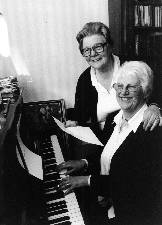
Ina Lawson & Mary Arthur |
Next issue:
In our new
format,
we catch
up with
those old
Dunning
favourites,
The Merrymakers
|
After ten years, | |
|
with photos |

|
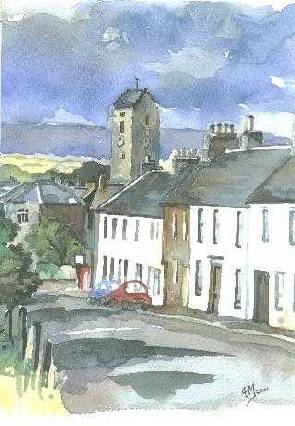
|
plus interesting |


